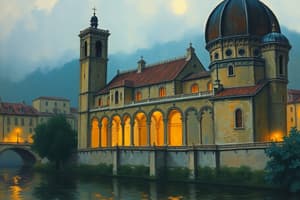Podcast
Questions and Answers
What was the typical material used for constructing Romanesque buildings?
What was the typical material used for constructing Romanesque buildings?
Brick, limestone, granite, and flint
What was the primary influence on Romanesque art, particularly in painting?
What was the primary influence on Romanesque art, particularly in painting?
Byzantine art
What is the primary function of a vault in Romanesque architecture?
What is the primary function of a vault in Romanesque architecture?
To cover a space with a ceiling or roof
What is the characteristic shape of arches used in Romanesque architecture?
What is the characteristic shape of arches used in Romanesque architecture?
What is the term used to describe the solid and compact appearance of Romanesque buildings?
What is the term used to describe the solid and compact appearance of Romanesque buildings?
What is the name of the famous cathedral in France that showcases Romanesque architecture?
What is the name of the famous cathedral in France that showcases Romanesque architecture?
What was the primary medium used for medieval fresco painting?
What was the primary medium used for medieval fresco painting?
What is the term used to describe the art of Europe from approximately 1000 AD to the rise of the Gothic style?
What is the term used to describe the art of Europe from approximately 1000 AD to the rise of the Gothic style?
What was the significance of Byzantine art in the development of Romanesque art?
What was the significance of Byzantine art in the development of Romanesque art?
What is the characteristic of Romanesque architecture that was later replaced by the Gothic style?
What is the characteristic of Romanesque architecture that was later replaced by the Gothic style?
Flashcards are hidden until you start studying
Study Notes
Romanesque Architecture
- Characterized by monumental forms, especially sculpture and fresco painting
- Influenced by Byzantine art, especially in painting
- Buildings: churches, castles, and monasteries
- Materials: brick, stone, limestone, granite, and flint
- Walls: massive thickness, few and small windows and openings
- Look: solid and compact
Romanesque Sculpture
- Painted in bright colors, most of which have disappeared today
- Facades of churches decorated with subjects like Christ in Glory and the Last Judgement
- Size and shape adapted to fit into available space
- Human figures: unrealistic
- Examples: Creation and temptation of Adam and Eve, Modena, Italy (1110 CE), Tympanum of Vézelay Abbey, Burgundy, France (1130 CE)
Romanesque Painting
- Most important paintings were inside churches
- Human figures: rigid and schematic
- Bright colors used
- Figures outlined in black, with emphasized eyes and hands
- No background landscapes
- Three types: mural, panel, and miniature
- Techniques: fresco, distemper, wax painting, and fresco al secco
Gothic Painting
- Changed from stiff, simple forms to more relaxed and natural ones
- Artists mastered perspective and brought more complexity
- Practiced in four primary media: frescos, panel paintings, manuscript illumination, and stained glass
- Examples: Simone Martini, Fresco (1285-1344 CE), Madonna Enthroned with the Child (1278-80 CE)
Stained Glass
- Gothic architecture increased the amount of glass in large buildings
- Churches became taller and lighter, with walls thinned and stained glass used to fill larger openings
- Stained glass windows are complex mosaics of colored glass and lead, illustrating biblical stories and saints' lives
Studying That Suits You
Use AI to generate personalized quizzes and flashcards to suit your learning preferences.



